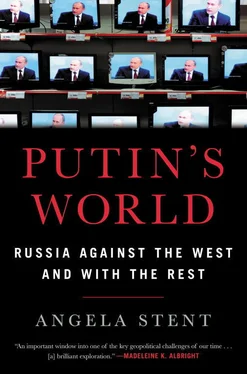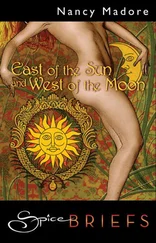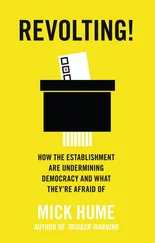In the years between Khrushchev’s rise and Gorbachev’s coming to power, Ukrainians were well integrated into Soviet society, with a disproportionately high percentage serving in the Soviet armed forces. Much of the Ukrainian intelligentsia was Russified and co-opted into the Soviet system. A quarter of the Soviet military-industrial complex was located in Eastern Ukraine. Periodically nationalist currents would assert themselves, but they would be suppressed. Mikhail Gorbachev himself embodied this Soviet reality, with a Ukrainian mother and a Russian father. When he came to power, his calls for glasnost were not immediately taken up by the more conformist Ukrainian party leadership. But events soon changed that. In 1986, the nuclear explosion at Chernobyl—including the initial cover-up that may ultimately have cost hundreds, if not thousands, of lives in Ukraine and the subsequent admission of guilt by the Soviet authorities—mobilized public opinion. 16Between 1986 and 1991, different Ukrainian nationalist groups organized themselves, pressuring for greater autonomy and, ultimately, for independence. Although much of the Ukrainian party ruling nomenklatura were reluctant nationalists, they were caught up in an accelerating process of state collapse as Soviet citizens took Gorbachev at his word and insisted on self-determination.
When asked at a lecture in the Library of Congress some years after the Soviet collapse what his greatest mistake had been, Gorbachev paused and said, “I underestimated the nationalities question.” Ever since the tsarist empire began to expand, eventually comprising more than one hundred different ethnic groups, the rulers’ challenge was to maintain centralized control over this complex mosaic of languages, cultures, and religions. The default instinct was Russification—the imposition of Russian language and culture on the population—which produced a counter-reaction and mobilized non-Russian groups to join the Bolsheviks. Eventually history repeated itself seventy-four years later. Like Soviet leaders before him, Gorbachev believed that the federal Soviet state, which had existed since 1922, had resolved the national question by granting limited cultural autonomy to different ethnic groups. This was especially true of Ukraine, viewed as the cradle of Russian history.
But in the end, Ukraine was instrumental in the collapse of the USSR. Throughout 1990 and 1991 Gorbachev sought to negotiate a new union treaty that would have held the USSR together by granting more autonomy for the union republics. How different things might have turned out had he succeeded. But just before the vote on a new treaty, a group of disgruntled hard-line officials staged a coup against Gorbachev while he was on vacation in Crimea. Shortly after the August 1991 putsch collapsed, Ukraine’s top legislative body the Supreme Soviet, under the leadership of party chief Leonid Kravchuk, declared its independence, much to Gorbachev’s dismay.
He was not the only official to oppose the Ukrainian move. President George H. W. Bush did everything he could to keep the Soviet Union alive. The US was very concerned about the security implications of a potential Soviet collapse because of the USSR’s vast nuclear arsenal. Just before the coup, in a speech in Kyiv, Bush admonished Ukrainians: “Freedom is not the same as independence. Americans will not support those who seek [independence] in order to replace a far-off tyranny with a local despotism. They will not aid those who promote a suicidal nationalism based upon ethnic hatred.” 17
In December 1991, the Ukrainian people voted in a referendum for independence: 90 percent supported independence, including 83 percent in the Donetsk region and 54 percent of the population of Crimea. Shortly thereafter, Boris Yeltsin met with Kravchuk and Belarusian leader Stanislau Shushkevich in the hunting lodge in the Belavezha Forest outside Minsk. What happened at that meeting? What promises were made? Revisionist interpretations of this meeting have fueled the current Russian narrative about Crimea. While the Russian delegation arrived with proposals for a reformed Slavic union, Kravchuk was determined that Ukraine emerge from the meeting with its independence. On the first night, dinner was dominated by a vigorous debate about whether some form of union could be preserved. Kravchuk argued with Yeltsin about whether the USSR should be completely dissolved. In the end, after two days of intense discussions, the three leaders emerged with a handwritten document (there were no typewriters in the hunting lodge) that dissolved the USSR. The Agreement on the Establishment of a Commonwealth of Independent States (CIS) consisted of fourteen articles. The three leaders agreed to recognize the territorial integrity and existing borders of each independent state. So ended seventy-four years of Soviet rule. Andrei Kozyrev, Yeltsin’s foreign minister, called George H. W. Bush to give him the news. As for Gorbachev, he was furious: “What you have done behind my back with the consent of the US president is a crying shame, a disgrace,” he told Yeltsin. 18
Almost from the beginning, Russians began to question the legality of the hastily written agreement. They hinted that a secret addendum would have permitted changes in borders were the local population to decide this by referendum. What is indisputable is that Kravchuk’s refusal to sign a new union treaty led to the Soviet Union’s demise. For that reason, some Russians blame Ukraine for precipitating what Putin has called “a major geopolitical disaster of the twentieth century.” 19
RUSSIA AND UKRAINE UNDER YELTSIN
The three signatories to the treaty that ended the USSR termed it a “civilized divorce.” But as the 1990s wore on, the Russian-Ukrainian divorce became increasingly acrimonious. Yeltsin’s main objective in convening the meeting that dissolved the USSR had been to oust Gorbachev from the Kremlin. He had not thought through the implications of ushering in an independent Ukrainian state. Four years later, it became clear that Yeltsin was having second thoughts about the security implications of the Soviet breakup. A September 1995 presidential decree, laying out Russia’s security interests in the CIS and the imperative of protecting the rights of Russians living there, stated that “this region is first of all Russia’s zone of influence.” 20Almost from the beginning, Russian officials sought to reinforce that decision by using the extensive financial, trade, personal, political, and intelligence networks that bound the two societies together to undermine Ukrainian sovereignty and strengthen dependence on Moscow. The Russian Duma, even in its early, more pluralistic incarnation, intervened on several occasions to declare that Crimea was Russian, backed by Moscow’s powerful and outspoken mayor Yuri Luzhkov, who had extensive personal investments on the peninsula. Domestic developments inside Ukraine served to facilitate these Russian endeavors. In the 1990s, Ukraine developed a more pluralistic political system than that in Russia but one ruled by corrupt, oligarchic clans that failed to build transparent institutions of government and law strong enough to resist Russian meddling. The energy sector was particularly corrupt, with opaque middlemen—both Ukrainian and Russian—amassing fortunes from the transit system that carried Russian gas to Europe via Ukraine. 21
Three issues dominated Russia-Ukraine relations in the 1990s: nuclear weapons, the disposition of the Black Sea Fleet, and Crimea. When the USSR collapsed, Ukraine was the world’s third largest nuclear state after the United States and Russia, with one-third of the Soviet nuclear arsenal and significant capacities in design and production. It had 2,000 strategic nuclear warheads and 2,500 tactical nuclear weapons. Immediately after the Soviet collapse, the fate of Ukraine’s nuclear arsenal became an urgent matter for US policy makers. The prospect of “loose nukes” set off alarms in the White House. The issue dominated Washington’s policy toward Ukraine during the last year of the George H. W. Bush administration and the first years of the Clinton administration. 22The United States was determined that Russia be the only nuclear state in the post-Soviet space. That meant Ukraine, Belarus, and Kazakhstan (the latter two also had nuclear weapons on their territories) should transfer their warheads and delivery systems to Russia, which would destroy them. Initially, Washington wanted Russia to handle the negotiations with its three post-Soviet neighbors, but that proved impossible. So in the end the United States negotiated with all four states to accomplish denuclearization.
Читать дальше












